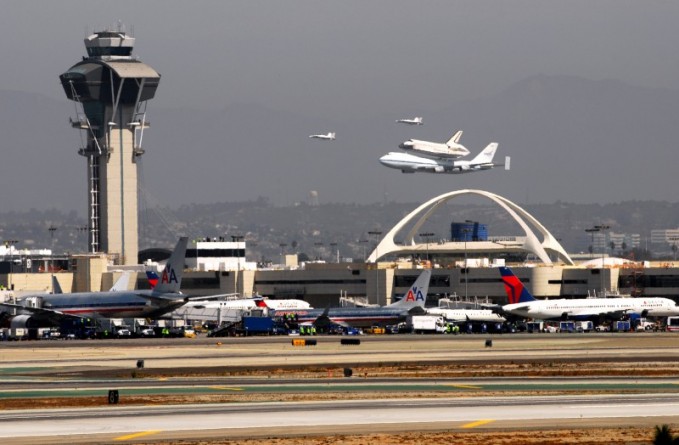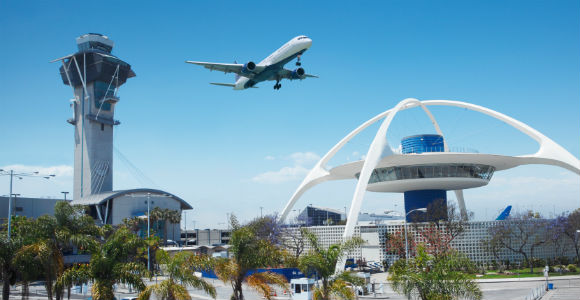
Arecord 70.6 million passengers a year now pass through Los Angeles International Airport as it undergoes a multibillion-dollar "world class" modernization.
Passenger terminals, like Tom Bradley International, are being remodeled with upscale shopping and dining. Runways are being refurbished, and public transit is finally on the way.
But high up in the control tower of the nation's second-busiest airport, the outlook is not so good. Air traffic controllers are working longer and harder than ever to safely handle the enormous volume of aircraft that arrives and departs at this prominent West Coast gateway.
Overtime is soaring and serious staff shortages loom despite warnings issued in 2009 by the inspector general for the U.S. Transportation Department.
The dropout rate for trainees has been as high as 60%, and many controllers routinely work more than five days a week, raising concerns about fatigue. The situation has become so bad even seasoned professionals seek reassignment to less stressful airports.
"It's gotten worse," said Mike Foote, an LAX air traffic controller and local representative of the National Air Traffic Controllers Assn. "We are not saying the sky is falling or an accident is imminent. But fatigue is a real thing. We are tired, and we have been grinding this out for years. It is in the best interest of everyone, especially the flying public, that the staffing and overtime issues get resolved."
Federal Aviation Administration officials said they share the controllers' concerns and that steps are being taken at LAX and facilities across the country to attract and train additional personnel. Several rounds of hiring have occurred during the last two years, they added, and more recruitment drives are planned.
The controllers association said some of the most acute staff shortages are at five air traffic control centers that guide aircraft into several dozen major airports. They include Atlanta Hartsfield Jackson, Chicago O'Hare, Dallas-Fort Worth, and Houston Intercontinental as well as La Guardia and John F. Kennedy in New York.
But LAX is "in worse shape than a lot of the facilities we have concerns about because of the complexity of the traffic," said Patricia Gilbert, executive vice president of the controllers association. "You just can't take an academy graduate and expect him or her to qualify in a complicated tower like LAX's."
The FAA and union leaders attribute most of the problem at LAX to three major things: deep congressional budget cuts, an unexpectedly heavy rate of retirements and the complexities of maneuvering hundreds of commercial planes a day — from regional carriers to international jumbo jets — around a relatively small, 3,500-acre airfield surrounded by urban development.
Though staffing numbers can be fluid, LAX now has 39 fully certified controllers and 11 trainees who were credentialed at other airports but need to learn local procedures. Foote says 19 controllers are eligible to retire or are awaiting retirement dates. Three others could become supervisors.
According to the association and the inspector general's 2009 audit, the number of fully certified air traffic controllers at LAX has dropped from 45 in 2004. Meanwhile, overtime has continued to climb, from 5,866 hours in fiscal year 2008 to 13,396 hours in fiscal 2015. There were 606 hours of overtime in 2006.

The vast majority of extra hours, Foote said, are absorbed by fully certified controllers, many of whom have been putting in at least 40 six-day workweeks a year.
The annual salary of a typical controller is about $122,500, according to the federal Bureau of Labor Statistics, with overtime paid at time and a half.
Reports by the federal Government Accountability Office and the National Transportation Safety Board show that high levels of overtime and understaffing at air traffic control facilities have potential implications for aviation safety and the efficient handling of the multimillion-dollar aircraft they guide.
The NTSB has found that errors by tired controllers have contributed to serious runway incursions, where planes stray too close to where others might be moving. If staffing levels decline enough, it could at least lead to slowdowns in airport operations and trigger delays for travelers.
Foote believes that 52 certified controllers, plus 10 trainees, would be adequate to staff LAX around the clock. He said they are necessary given a dramatic surge in air traffic, modernization projects on the airfield that require more ground control and the wider use of very large passenger jets that need special procedures to move safely around the airport.
LAX, which has experienced a 5% to 6% annual growth rate due to a resurgent economy, now handles about 9 million more passengers a year than in 2005.
During the summer, daily arrivals and departures on the airport's four runways regularly exceed 2,000. This fall, flights have been reaching 1,800 to 1,900 a day, at least 28% more than in 2009.
Controllers oversee it all from a centralized 22-story tower, which has a 360-degree view of the airport. They work eight-hour shifts — morning, swing and graveyard.
During the busiest times of day, controllers must handle about 120 to 130 aircraft an hour, or one about every 30 seconds. The busiest times are 9 a.m. to 10 a.m. The slowest are 1 a.m. to 5 a.m.
In addition to the rising workload, Foote said there are other disincentives for controllers to remain at LAX or to transfer there, including better pay and lower costs of living in other parts of the country.
"I am sending out all the paperwork I can, trying to leave," said one 20-year controller, who would speak only on condition that his name not be used for fear of upsetting his supervisors. "Let's say the atmosphere at LAX offers a lesser quality of life and I'm tired of the work schedule."
The controller said he has been placed on mandatory overtime, which means he must work extra hours when needed. He estimated that he has put in 35 to 38 six-day workweeks so far this year. During the busy summer months, he said, all controllers were on mandatory overtime.
"I've never seen it like this," he said.
To attract more controllers to openings at LAX, FAA officials say they have streamlined training and installed an air traffic control simulator in the tower. Applicants must be certified as controllers at other airports before they can enter LAX's training program — a policy designed to avoid the high failure rate encountered with inexperienced trainees.
There are also cash incentives, and controllers who move from other local airports to LAX are now allowed to transfer back if they can't complete the training.
"All are successful and helpful things, but they are limited in scope," Foote said. "LAX is a difficult facility to staff due to the complexity of airport operations and personnel shortages. With the constant grind day in and day out, air traffic controllers are not willing to do it after a while and we lose trained professionals. This is spreading throughout the entire air traffic control system."
Nationally, the ranks of certified controllers are at a 27-year low. Since September 2012, the number of fully certified staff has declined from 11,735 to 10,859, of which 3,257 are eligible to retire this year.
However, the FAA was 34% below its hiring goal for 2015 — the fifth straight year it has missed its numbers.
"People are generally retiring sooner rather than later and in higher numbers than the FAA expected. They are saying they just can't work like this anymore," said Gilbert.
Contributing to the problem were automatic spending cuts triggered by Congress' Budget Control Act of 2011 that later become known as the 2013 sequestration. That austerity move forced the agency to shut down its air traffic control academy for nine months.
Association officials say adequate funding is still uncertain and there has been a lack of incentives to attract and keep people at the more demanding facilities.
Gilbert said the association also is concerned about chronic fatigue at the more complex airports and an inability to pull controllers off the line to work on training or to test new procedures and technology.
Last month, association officials went to Congress and asked the House aviation subcommittee to hold hearings into the matter. Committee members have yet to decide to do so.
"About 15,000 certified controllers would be a more comfortable level," Gilbert said. "We'd like to get to the point where we can meet the FAA's hiring goals."
Source: latimes

